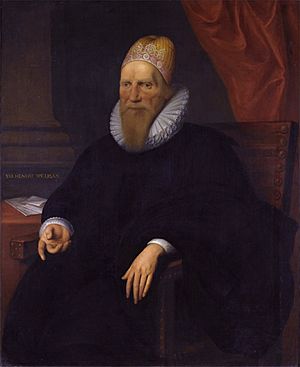Henry Spelman facts for kids
Sir Henry Spelman (born around 1562 – died October 1641) was an important English historian. He was known for carefully collecting old records, especially those about church meetings and history from the Middle Ages.
Contents
Sir Henry Spelman's Life Story
Sir Henry Spelman was born in a place called Congham in Norfolk, England. He was the oldest son in his family. He went to Trinity College, Cambridge and finished his studies there in 1583.
His Work in Government and Law
Sir Henry became a Member of Parliament (MP) for Castle Rising in Norfolk. This meant he helped make laws for the country. He served in Parliament in 1593 and again from 1597 to 1598. In 1603, the King gave him the special title of "Sir," making him a Knight. The next year, he became the High Sheriff of Norfolk, which was an important local job.
In 1612, he moved to London to be closer to his friend, Sir Robert Bruce Cotton. Sir Henry also helped with legal issues. For example, in 1617, he was part of a group that looked into land disputes in Ireland. He also helped investigate unfair taxes collected by the government and church courts. He continued to serve as an MP, this time for Worcester in 1625.
Sir Henry was also interested in new lands across the sea. In 1627, he became the money manager for the Guiana Company. He was also an active member of the council for New England. Because of all his helpful work for the country, he received a gift of money in 1636. Two years later, he was offered a leadership role at Sutton's Hospital.
Sir Henry Spelman passed away in London in October 1641. He was buried in the famous Westminster Abbey.
Sir Henry Spelman's Family Life
On April 28, 1590, Sir Henry Spelman married Eleanor. She was the daughter of John Lestrange from Sedgeford in Norfolk.
His nephew, who was also named Henry Spelman, became well-known as a translator in America.
In his later years, Sir Henry lived with his son-in-law, Sir Ralph Whitfield. Sir Henry had several children who survived him, including his sons John Spelman and Clement Spillman. He also had a daughter named Catherine, who married an important government official.
Sir Henry Spelman's Books and Collections
Sir Henry Spelman wrote several important books and collected many historical documents.
Key Historical Works
One of his main works was Concilia Ecclesiastica Orbis Britannici, published in 1639. This book was a collection of records from church councils in Britain. Another important work was Glossarium Archaiologicum, which was finished by William Dugdale after Sir Henry's death. His collection of writings, Reliquiae Spelmannianae, was put together by Edmund Gibson in 1698.
Sir Henry was very interested in what happened to the land that belonged to monasteries. These monasteries were closed during the English Reformation. He studied the family histories of landowners near his home in Norfolk. He wanted to see if families who took over church lands faced any bad luck or problems.


